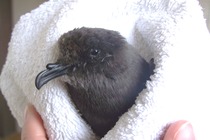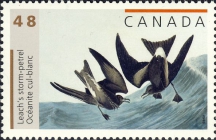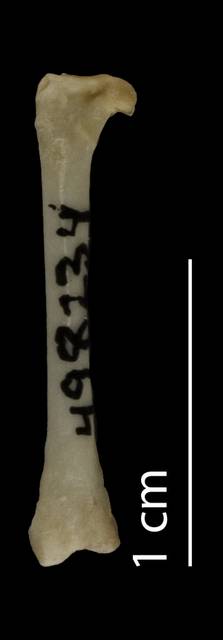
| Introduction | | Search taxa | | Taxon tree | | Taxon match | | Checklist | | Literature | | Stats | | Photogallery | | OBIS Vocab | | Log in |
CaRMS taxon detailsOceanodroma leucorhoa (Vieillot, 1818)
137192 (urn:lsid:marinespecies.org:taxname:137192)
accepted
Species
marine, terrestrial
(of ) Vieillot, L.P. (1818). Les Petrels. Procellaria. <em>Nouveau dictionnaire d'histoire naturelle.</em> 25: 413-424., available online at https://www.biodiversitylibrary.org/page/18044182
page(s): 422 [details]
Description Palearctic migrant
Description Palearctic migrant [details] Distribution circum-global
Distribution circum-global [details] Distribution North America; range extends from Labrador to the Gulf of Maine
Distribution North America; range extends from Labrador to the Gulf of Maine [details]
CaRMS (2024). Oceanodroma leucorhoa (Vieillot, 1818). Accessed at: https://marinespecies.org/carms/aphia.php?p=taxdetails&id=137192 on 2024-04-26
Nozères, C., Kennedy, M.K. (Eds.) (2024). Canadian Register of Marine Species. Oceanodroma leucorhoa (Vieillot, 1818). Accessed at: https://marinespecies.org/carms/aphia.php?p=taxdetails&id=137192 on 2024-04-26
Date action by
original description
(of ) Vieillot, L.P. (1818). Les Petrels. Procellaria. <em>Nouveau dictionnaire d'histoire naturelle.</em> 25: 413-424., available online at https://www.biodiversitylibrary.org/page/18044182
page(s): 422 [details] context source (Schelde) Maris, T.; Beauchard, O.; Van Damme, S.; Van den Bergh, E.; Wijnhoven, S.; Meire, P. (2013). Referentiematrices en Ecotoopoppervlaktes Annex bij de Evaluatiemethodiek Schelde-estuarium Studie naar “Ecotoopoppervlaktes en intactness index”. <em>Monitor Taskforce Publication Series, 2013-01. NIOZ: Yerseke.</em> 35 pp. (look up in IMIS) [details] context source (Bermuda) Wingate, D. B. (1973). A Checklist and Guide to the Birds of Bermuda. David B. Wingate, Hamilton, Bermuda. [details] basis of record van der Land, J. (2001). Tetrapoda, <B><I>in</I></B>: Costello, M.J. <i>et al.</i> (Ed.) (2001). <i>European register of marine species: a check-list of the marine species in Europe and a bibliography of guides to their identification. Collection Patrimoines Naturels,</i> 50: pp. 375-376 (look up in IMIS) [details] additional source Banks, R.C., R.W. McDiarmid, and A.L. Gardner. 1987. Checklist of vertebrates of the United States, the U.S. Territories, and Canada. U.S. Fish and Wildlife Service Resource Publication No. 166. 79 p. [details] additional source Robbins, C. S. (1983). Golden field Guide to Birds of North America. Golden press. 360p. [details] additional source Linkletter, L. E. (1977). A checklist of marine fauna and flora of the Bay of Fundy. <em>Huntsman Marine Laboratory, St. Andrews, N.B.</em> 68: p. [details] additional source Peterson, R.T.; Peterson, V.M. (2002). A field guide to the birds of eastern and central North America. <em>Fifth Edition.</em> Peterson Field Guide Series. Houghton Mifflin Company. New York. 427 p. [details] additional source Squires, H. J. (1990). Decapod Crustacea of the Atlantic coast of Canada. <em>Canadian Bulletin of Fisheries and Aquatic Sciences.</em> 221: 532 p., available online at http://www.dfo-mpo.gc.ca/library/116743.pdf [details] additional source Vanner, M. (2003). The encyclopedia of North American birds. <em>Paragon Publishing.</em> 1-383. [details] additional source Brown, L.H., E.K. Urban & K. Newman. (1982). The Birds of Africa, Volume I. <em>Academic Press, London.</em> [details] additional source Muller, Y. (2004). Faune et flore du littoral du Nord, du Pas-de-Calais et de la Belgique: inventaire. [Coastal fauna and flora of the Nord, Pas-de-Calais and Belgium: inventory]. <em>Commission Régionale de Biologie Région Nord Pas-de-Calais: France.</em> 307 pp., available online at http://www.vliz.be/imisdocs/publications/145561.pdf [details] additional source King, C.M.; Roberts, C.D.; Bell, B.D.; Fordyce, R.E.; Nicoll, R.S.; Worthy, T.H.; Paulin, C.D.; Hitchmough, R.A.; Keyes, I.W.; Baker, A.N.; Stewart, A.L.; Hiller, N.; McDowall, R.M.; Holdaway, R.N.; McPhee, R.P.; Schwarzhans, W.W.; Tennyson, A.J.D.; Rust, S.; Macadie, I. (2009). Phylum Chordata: lancelets, fishes, amphibians, reptiles, birds, mammals. <em>in: Gordon, D.P. (Ed.) (2009). New Zealand inventory of biodiversity: 1. Kingdom Animalia: Radiata, Lophotrochozoa, Deuterostomia.</em> pp. 431-554. [details] additional source Gallardo, J. C.; Macías, V.; Velarde, E. (2009). Birds (Vertebrata: Aves) of the Gulf of Mexico. <em>In: Felder, D.L. and D.K. Camp (eds.), Gulf of Mexico–Origins, Waters, and Biota. Biodiversity. Texas A&M Press, College Station, Texas.</em> Pp. 1321–1342. [details] additional source Integrated Taxonomic Information System (ITIS). , available online at http://www.itis.gov [details]  Present Present  Inaccurate Inaccurate  Introduced: alien Introduced: alien  Containing type locality Containing type locality
From other sources
Breeding Category Vagrant [details]Description Palearctic migrant [details] Dimensions Length: 8" (20cm) [details] Distribution circum-global [details] Distribution North America; range extends from Labrador to the Gulf of Maine [details] IUCN Red List Category Least Concern [details] Predators gulls [details] Reproduction Breeding ground are in the Grand Manan area in late April or early May and Breeding starts early in June. The female deposits a single egg at the end of a borrow several feet long dug in either grassy or wooded locations. They come in from sea to their burrows only at night and leave before daylight or remain in their burrows until the next night. Incubation takes 40 days. Eggs are laid from mid June to mid July. [details]
To AviBase
To Barcode of Life (19 barcodes) To Biodiversity Heritage Library (331 publications) To Biological Information System for Marine Life (BISMaL) To GenBank (361 nucleotides; 120 proteins) To NMNH Extant Collection (Hydrobatidae (Storm Petrels), USNM 498234, femur, caudal) To PESI To Wikipedia To ITIS |





